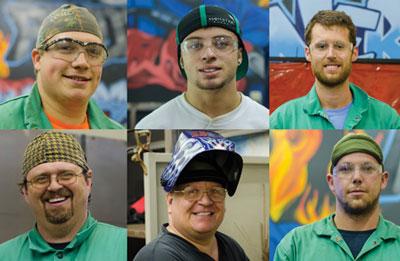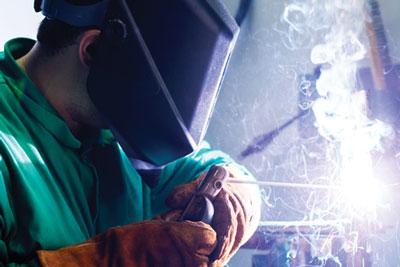Senior Editor
- FMA
- The Fabricator
- FABTECH
- Canadian Metalworking
Categories
- Additive Manufacturing
- Aluminum Welding
- Arc Welding
- Assembly and Joining
- Automation and Robotics
- Bending and Forming
- Consumables
- Cutting and Weld Prep
- Electric Vehicles
- En Español
- Finishing
- Hydroforming
- Laser Cutting
- Laser Welding
- Machining
- Manufacturing Software
- Materials Handling
- Metals/Materials
- Oxyfuel Cutting
- Plasma Cutting
- Power Tools
- Punching and Other Holemaking
- Roll Forming
- Safety
- Sawing
- Shearing
- Shop Management
- Testing and Measuring
- Tube and Pipe Fabrication
- Tube and Pipe Production
- Waterjet Cutting
Industry Directory
Webcasts
Podcasts
FAB 40
Advertise
Subscribe
Account Login
Search
Welding labor market: Where the best welders are going and why
How schools and companies are fixing a broken skilled-labor pipeline
- By Tim Heston
- Updated February 3, 2023
- January 13, 2014
- Article
- Arc Welding

Fabricators say welding remains one of the most sought-after skills in metal fabrication. Why are they having such difficulty finding people who know the trade?
In survey after survey, fabricators say welding remains one of the most sought-after skills in metal fabrication. Why are they having such difficulty finding people who know the trade?
Modern helmets and fume extraction technologies mean that many welders need not spend their days in dark, smoky environs. Some young welders who gain the right certifications find themselves making livable, family-supporting wages just a few years into their careers. Those who move to follow the money and gain some experience in the field, be it to the Bakken oilfields or on an offshore rig, may be raking in six figures. Of course, such jobs usually don’t come with a conventional family life. Then again, some leave the welding profession for jobs in retail—because it may be easier, and the entry-level pay may be about the same.
Low starting wages have industry watchers befuddled. In one New York Times article published in November 2012, reporter Adam Davidson quoted The Boston Consulting Group. This same consultancy that predicted a manufacturing renaissance also wrote a report that called into question the skilled-labor crisis. “Trying to hire high-skilled workers at rock-bottom rates is not a skills gap,” it said.
“If there’s a skill shortage, there has to be rises in wages. It’s basic economics,” Mark Price, a labor economist at the Keystone Research Center, told Davidson.
So what’s really going on in welding? Why aren’t labor market forces working the way people think they should? Why is it still one of the most difficult skills for fabricators to hire? And perhaps most important, what can fabricators do to find the best welding talent?
Too Many Entry-level Welders
Dan Turner, welding professor at Yuba College, Marysville, Calif., brought up an under-reported reality in many job markets around the country, and it’s one that may solve the mystery as to why increased starting pay hasn’t accompanied the skilled-labor shortage everywhere. “We have a glut of entry-level welders,” he said. “What we lack are experienced welders.”
Turner relayed a typical situation that helps explain the entry-level talent glut. Small shops dominate metal fabrication. The company may have just a handful of welders, and the most experienced (and often best) may be getting ready to retire.
“They have tons of experience,” he said. “They know the ins and outs of every piece of welding equipment you have. Then he announces he’s going to retire in a month. So managers go out and find somebody to replace him—and they can’t. The best new welding talent may be able to pass a certification test, but that certification still can’t replace years of experience and on-the-job training.
“We have plenty of entry-level welders out there, and companies can hire them,” Turner continued. “But they’re just that—entry-level.” He added that, ideally, the fabricator should have thought about hiring a successor three to five years ago. But, of course, thanks to the economy, that’s when many fabricators weren’t in a position to hire.
Tim Baber, professor and chair of welding technology at College of the Canyons, Santa Clarita, Calif., described how many of the region’s most progressive employers offer internship programs. These not only give welders college credit, they give them a taste of life in a welding shop. Dubbed the Cooperative Work Experience Education, or CWEE, the semester-long internships—some paid, some unpaid—give students 10 hours a week of experience with a journey-level individual at a local company.
The program gives students a taste of what it’s really like to work as a welder so they can decide whether the career is right for them. It also gives employers a chance to test the waters with new talent. Some of the best students find a job offer waiting for them at the end of their internship.
Perception Versus Reality in the Welding Labor Market
Baber added that such real-world experience can be a real eye-opener for some students, mainly because popular perception of welding is a bit different than reality. Cable TV and other mass media outlets show renegade welders rebuilding hot rods in record time. Welders aren’t buttoned-down types; they’re independent, a bit wild, and follow their own star—at least that’s the perception.
“When you talk to large companies, they want to hire professionals,” Baber said. “I walk the FABTECH® show in a button-down shirt, tie, and slacks. I see the people who are driving the industry, and they’re not the people on TV.”
The exposure on reality TV, he said, is a mixed blessing. It has drawn attention to the welding craft. But the typical welding job isn’t reality-show fodder.
“Also, we can’t ignore the drug issue,” Baber said. “I have seen fabulous welders who don’t get a job because they cannot pass a drug test. There may be substance abuse, or it may be recreational. Regardless, if they smoke a joint on the weekend, that makes them unemployable. It’s self-defeating.”
Ryan Blythe has seen this too. He previously worked as an administrator at a now shuttered technical school in Georgia. There were many reasons the school closed, but he did say the school taught many people who got into welding as a second career. Some were previously incarcerated, and many had serious financial challenges.
He emphasized that there’s nothing wrong with this. Welding can be a great second career for people trying to get back on their feet. In a quest to overcome personal or financial difficulties, learning a trade can be a vital piece of the puzzle, but it can’t be the only piece. No matter how good a welder is, he has to show up for work consistently, be on time, be engaged, and pass a drug test.
In 2012 Blythe decided to take a new approach when launching the Georgia Trade School in Kennesaw, Ga. The school does not accept financial aid or government grants. “Everyone who comes here pays their own way,” Blythe said. “That concept has been so successful for us, because everybody has skin in the game. The students we teach have a passion for welding. They’re not being made to do this because their unemployment benefits extension requires them to do a job training program.”
Blythe markets the school to students in surrounding Cobb County, an Atlanta suburb. The local school district is one of the top rated in the state, with a strong emphasis on science, technology, engineering, and math (STEM). The student welders at Georgia Trade School have done well enough in high school that they could go on to get a four-year degree. They just happen to choose welding.
“We needed to have a school that was designed to attract a very young demographic,” Blythe said. “The average age of a welder keeps going up, but we have a lot of schools that are basically attracting career changers. Why can’t we go recruit directly from high schools and get kids to go to a welding school who would otherwise be going to a four-year college?”
He added that now is an opportune time to change an unfortunate perception about vocational, trade-based education. Parents see children dig themselves into seemingly insurmountable debt pursuing a four-year degree that probably won’t help them pay off that debt anytime soon. This makes welding and other trade-based skills attractive career options. “So many kids are coming out of school with a major that doesn’t have any labor market value,” he said.
Data buttresses this perception. In the 2013 Salary/Wage & Benefit Survey from the Fabricators & Manufacturers Association International, a code welder (certified to AWS, ASME, or other codes) had the broadest salary range of any shop floor position, stretching up to $83,000—and this is a base salary, not including overtime and bonuses. And nearly all respondents were from job shops and contract fabricators. True, starting pay can be on the low end. This isn’t a get-rich-quick business. But pay can rise significantly over time.
This in turn helps overcome the stereotype. Vocational education shouldn’t be a fallback, a path to pursue only if better options aren’t there. In many cases, vocational education is the better option, even for the best, brightest, and most engaged students. And this, ultimately, is the kind of people fabricators are looking for.
Since launching last year, Georgia Trade School has expanded its schedule to meet increasing demand. “We now teach welding from 7 in the morning until 10 at night,” Blythe said, “and we have about a three-month-long waiting list to get in.”
Still, regardless of how bright those students are, Blythe emphasized that the school still produces entry-level welders. It works closely with various companies in the Southeast, including Huntington Ingalls Industries, the Mississippi shipyard, on how to prepare people. And companies, of course, have their own welding test that all job applicants must pass—but again, it remains that: an entry-level test.
“I’ve backed away from employers who aren’t willing to train,” he said. “No matter how many certifications a new welder may have, he’s not going to be the perfect worker on day one.”
The Welding Labor Market and Career Outlook
When it comes to the skilled-welder shortage, there’s no shortage of finger-pointing. Fabricators point fingers at schools for not supplying enough welding graduates. Teachers point at manufacturers for not providing sufficient on-the-job training. All, however, agree that the talent pipeline is broken. How can it be fixed?
Many fabricators have stepped up their in-house training programs. Yes, there’s a risk that the employee may leave for another job, but what’s the alternative? After all, a shop can have the fanciest laser and most intuitive press brakes, but if its welders continually leave, a fabricator will find it hard to stay competitive.
Fabricators like DeWys Manufacturing near Grand Rapids, Mich., and Schuette Metals in Wausau, Wis., have launched in-house welding schools. South Bend, Ind.-based General Sheet Metal Works recently restructured its business to include an in-house trainer in every department, including welding and joining.
On the education side, Baber recently returned from a conference in the northwestern U.S. that hinted at a sea change when it comes to technical jobs in general. Currently most employers are looking for welders who can pass certain tests and certifications. The tests aren’t easy. Students may need to know how to weld 6G around pipe, weld out-of-position, or know which welding wire or rod works best with which weld settings and shielding gas—and why. But few job openings require an associate’s degree, so why get one?
At the conference, Baber said he learned that some major employers are changing job requirements. Many jobs that previously required a bachelor’s degree soon may require only an associate’s degree. This may change the welding education landscape and draw more people into the technical fields. Graduating with an associate’s degree in welding technology may give students a jump-start on a career path that previously wasn’t possible without four years of college.
The best welding talent wants a career path, and not all employers offer a good one. Baber recalled one local employer that continually pays welders near minimum wage, wants welders with numerous qualifications, but has yet to invest in proper fume extraction or ventilation equipment. Few of its welders last more than a year. “I keep telling them that I can’t recommend or promote their company,” he said.
On the other hand, Turner recalled one engaged student who graduated and started work at a local fabricator. After a few days on the job, he saw that the company had a pulse wire welding machine sitting in the corner, gathering dust. He asked why the system wasn’t being used, and his supervisor said it never worked. He asked what kind of shielding gas was being used—the wrong one for the application, as it turned out. He approached the problem with subtlety and respect. He wasn’t a cocky know-it-all, just an engaged youth with earnest questions.
“This was a student with a knowledge of shielding gases and the application of specific processes,” Turner said. “The third day he was there, he got a $2-an-hour raise because he improved their production with the pulse process. He made a difference, and now that student is in charge of an entire division. He’s excited about going into work every day.”
Turner added that this story pretty much sums up what many of the best welders coming out of school today want. “Everybody wants higher pay,” he said. “But what really attracts them are the working conditions, how they’re treated, and how they feel when they work there. They want the ability to make suggestions.
“They want to be treated like they’re worth something—like they matter.”
About the Author

Tim Heston
2135 Point Blvd
Elgin, IL 60123
815-381-1314
Tim Heston, The Fabricator's senior editor, has covered the metal fabrication industry since 1998, starting his career at the American Welding Society's Welding Journal. Since then he has covered the full range of metal fabrication processes, from stamping, bending, and cutting to grinding and polishing. He joined The Fabricator's staff in October 2007.
subscribe now

The Fabricator is North America's leading magazine for the metal forming and fabricating industry. The magazine delivers the news, technical articles, and case histories that enable fabricators to do their jobs more efficiently. The Fabricator has served the industry since 1970.
start your free subscription- Stay connected from anywhere

Easily access valuable industry resources now with full access to the digital edition of The Fabricator.

Easily access valuable industry resources now with full access to the digital edition of The Welder.

Easily access valuable industry resources now with full access to the digital edition of The Tube and Pipe Journal.
- Podcasting
- Podcast:
- The Fabricator Podcast
- Published:
- 04/16/2024
- Running Time:
- 63:29
In this episode of The Fabricator Podcast, Caleb Chamberlain, co-founder and CEO of OSH Cut, discusses his company’s...
- Trending Articles
Capturing, recording equipment inspection data for FMEA

Tips for creating sheet metal tubes with perforations

Are two heads better than one in fiber laser cutting?

Supporting the metal fabricating industry through FMA

Omco Solar opens second Alabama manufacturing facility

- Industry Events
16th Annual Safety Conference
- April 30 - May 1, 2024
- Elgin,
Pipe and Tube Conference
- May 21 - 22, 2024
- Omaha, NE
World-Class Roll Forming Workshop
- June 5 - 6, 2024
- Louisville, KY
Advanced Laser Application Workshop
- June 25 - 27, 2024
- Novi, MI





























